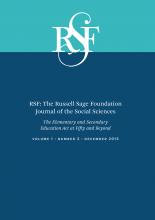Research ArticleI. Consequences of the Elementary and Secondary Education Act
Open Access
ESEA and the Civil Rights Act: An Interbranch Approach to Furthering Desegregation
Erica Frankenberg, Kendra Taylor
RSF: The Russell Sage Foundation Journal of the Social Sciences December 2015, 1 (3) 32-49; DOI: https://doi.org/10.7758/RSF.2015.1.3.02
Erica Frankenberg
aAssociate professor, Pennsylvania State University
Kendra Taylor
bDoctoral student, Pennsylvania State University

REFERENCES
- ↵
- Abernathy, Charles F
- ↵Bass, Jack. 1990. Unlikely Heroes. Tuscaloosa: University of Alabama Press.
- ↵Bolner, James, and Robert A. Shanley. 1974. Busing: The Political and Judicial Process. New York: Praeger Publishers.
- ↵Bonilla-Silva, Eduardo. 2010. Racism without Racists: Color-Blind Racism and the Persistence of Racial Inequality in America, 3rd ed. Lanham, Md.: Rowman & Littlefield.
- ↵
- Cascio, Elizabeth,
- Nora Gordon, ,
- Ethan Lewis, , and
- Sarah Reber
- ↵
- Doherty, Patric J
- ↵
- ↵
- ↵Halpern, Stephen C. 1995. On the Limits of the Law: The Ironic Legacy of Title VI of the 1964 Civil Rights Act. Baltimore, Md.: Johns Hopkins University Press.
- ↵House of Representatives Subcommittee No. 5 of the Committee on the Judiciary. 1963. “Civil Rights” 88th Congress, 1st session committee print. Washington: U.S. Government Printing Office. Available at ProQuest Congressional (accessed March 24, 2015).
- ↵Jeffries, John C. 1994. Justice Lewis F. Powell, Jr. New York: C. Scribner's Sons.
- Kennedy, Edward M
- Kennedy, John F. 1963. “Radio and Television Report to the American People on Civil Rights,” June 11, 1963. Online by Gerhard Peters and John T. Woolley, The American Presidency Project. Available at: http://www.presidency.ucsb.edu/ws/?pid=9271 (accessed July 17, 2015).
- ↵Klarman, Michael. 2005. Brown v. Board of Education and the Civil Rights Movement. New York: Oxford University Press.
- ↵McGuinn, Patrick, and Frederick Hess. 2005. Freedom from Ignorance? The Great Society and the Evolution of the Elementary and Secondary Education Act of 1965. Amherst: University of Massachusetts Press.
- ↵Marshall, Burke. 1962. Federalism and Civil Rights. New York: Columbia University Press.
- ↵Meranto, Philip J. 1967. The Politics of Federal Aid to Education in 1965. Syracuse, N.Y.: Syracuse University Press.
- ↵Miller, Mark C., and Jeb Barnes. 2004. Making Policy, Making Law: An Interbranch Perspective. Washington, D.C.: Georgetown University Press.
- ↵National Coalition for School Diversity. 2014. “Federal Support for School Integration: A Status Report.” Washington, D.C. Available at: http://www.school-diversity.org/pdf/DiversityIssueBriefNo4.pdf (accessed October 21, 2015).
- ↵Nixon, Richard. 1970. “Statement About Desegregation of Elementary and Secondary Schools,” March 24, 1970. Online by Gerhard Peters and John T. Woolley, The American Presidency Project. Available at: http://www.presidency.ucsb.edu/ws/?pid=2923 (accessed July 17, 2015).
- ↵Orfield, Gary. 1969. The Reconstruction of Southern Education: The Schools and the 1964 Civil Rights Act. New York: Wiley-Interscience.
- ↵Orfield, Gary. 1975. Congressional Power: Congress and Social Change. New York: Harcourt Brace Jovanovich.
- ↵Orfield, Gary. 1978. Must We Bus? Segregation and National Policy. Washington, D.C.: Brookings Institution Press.
- ↵Orfield, Gary. 2000. “The 1964 Civil Rights Act and American Education.” In Legacies of the 1964 Civil Rights Act, edited by Bernard Grofman. Charlottesville: University of Virginia Press.
- ↵Orfield, Gary. 2015. “Lyndon Johnson and American Education.” In LBJ's Neglected Legacy: Reshaping the Federal Government, edited by Robert H. Wilson, Norman J. Glickman, and Laurence E. Lynn Jr. Austin: University of Texas Press.
- ↵Orfield, Gary, and Erica Frankenberg. 2014. Brown at 60: Great Progress, a Long Retreat and an Uncertain Future. Los Angeles, Calif.: Civil Rights Project/Proyecto Derechos Civiles.
- ↵Reed, Douglas S. 2014. Building the Federal Schoolhouse: Localism and the American Education State. New York: Oxford University Press.
- ↵Ryan, James E. 2010. Five Miles Away, a World Apart: One City, Two Schools, and the Story of Educational Opportunity in Modern America. New York: Oxford University Press.
- ↵U.S. Commission on Civil Rights (USCCR). 1966. “Survey of School Desegregation in the Southern and Border States 1965–66.” Washington: Government Printing Office.
- ↵U.S. Department of Education. 2014. “Office for Civil Rights Resource Comparability Materials.” Available at: http://www2.ed.gov/about/offices/list/ocr/resourcecomparability.html (accessed August 15, 2015).
- U.S. Department of Health, Education, and Welfare (HEW). Office of Education. 1966. “Status of Compliance Public School Districts Seventeen Southern and Border States: Report No. 1.” Washington: Government Printing Office.
- U.S. Department of Health, Education, and Welfare (HEW). Office of Education. 1967a. “Status of Compliance Public School Districts Seventeen Southern and Border States: Report No. 4.” Washington: Government Printing Office.
- U.S. Department of Health, Education, and Welfare (HEW). Office of Education. 1967b. “Status of Compliance Public School Districts Seventeen Southern and Border States: Report No. 7.” Washington: Government Printing Office.
In this issue
ESEA and the Civil Rights Act: An Interbranch Approach to Furthering Desegregation
Erica Frankenberg, Kendra Taylor
RSF: The Russell Sage Foundation Journal of the Social Sciences Dec 2015, 1 (3) 32-49; DOI: 10.7758/RSF.2015.1.3.02
Jump to section
Related Articles
- No related articles found.
Cited By...
- No citing articles found.





